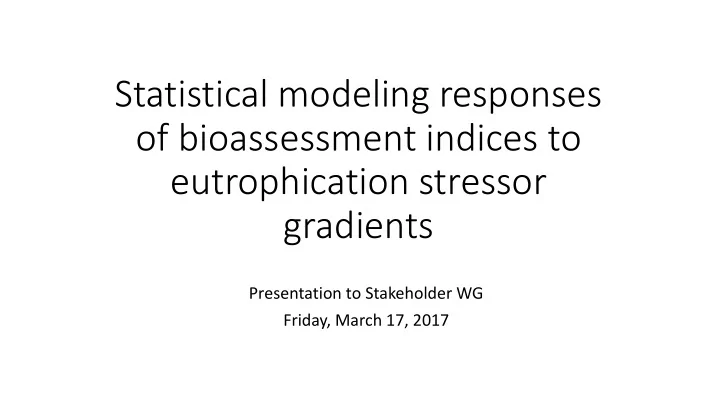

Statistical modeling responses of bioassessment indices to eutrophication stressor gradients Presentation to Stakeholder WG Friday, March 17, 2017
Objectives • Support decisions on numeric guidance (e.g., a numeric objective) for biostimulatory nutrients or conditions that protect biological integrity.
Process and Approach • Present stakeholder and regulatory advisory groups with overall approach, and ascertain key points to consider • Review approach with science panel, and identify best ways to tackle concerns • Present model results to advisory groups and review implications
Measuring Biostimulatory factors and eutrophication indicators • Nutrient concentrations: Total N and Total P • Organic matter: Benthic chl A or AFDM, streambed algae cover Other co-factors we may include (but don’t need numeric guidance now): • Biostimulatory conditions (temp, velocity, shading) • Habitat quality
Responses: measures of biological integrity • Benthic macroinvertebrates • CSCI • Benthic algae • Soft/Diatom indices (ASCIs) When available, we can link ranges of index scores linked to BCG bins. (in interim, we’ll use thresholds based on reference distributions) Species-level responses • Thresholds derived for species responses may be more protective than those derived for indices, but links to beneficial uses less clear. • May support diagnosis and causal assessment of eutrophication impacts.
How is our data set? • Samples statewide collected since mid 1990s (most since 2008) • Good representation of high- scoring sites across most regions • Sites in poor condition mostly in South Coast, Central Valley, Bay Area Likely biological condition Region Good Poor Other North Coast 84 4 40 Chaparral 72 30 58 South Coast 70 124 94 Central Valley 3 33 8 Sierra Nevada 164 3 34 Deserts and Modoc 39 10 26
Models let us link bio-integrity to bio- stimulation Could also put ASCI here Could also put TP, eutrophic responses here
Models let us link bio-integrity to bio- stimulation BCG bin 1/2 BCG bin 3 BCG bin 4 BCG bin 5/6 Thresholds derived through expert panel process. WB selects bins where protection is a priority.
Models let us link bio-integrity to bio- stimulation BCG bin 1/2 BCG bin 3 BCG bin 4 BCG bin 5/6 Several modeling approaches could be used to draw this line.
Models let us link bio-integrity to bio- stimulation BCG bin 1/2 BCG bin 3 BCG bin 4 BCG bin 5/6 Models allow us to identify numeric values associated with TN<0.2 each bin 50% of being in BCG 1/2 or better
Models let us link bio-integrity to bio- stimulation BCG bin 1/2 BCG bin 3 BCG bin 4 BCG bin 5/6 Models allow us to identify numeric values associated with TN<0.4 each bin 50% of being in BCG 3 or better
Models let us link bio-integrity to bio- stimulation BCG bin 1/2 BCG bin 3 BCG bin 4 BCG bin 5/6 Models allow us to identify numeric values associated with TN<1 each bin 50% of being in BCG 4 or better
Most of the “action” is at fairly low concentrations.
Algae likely to show a similar pattern.
Models allow us to explore different levels of risk tolerance TN > 2.5: 50% increase in risk of poor condition TN > 1: 20% increase in risk of poor condition
Considerations in developing a model • Several types of models may be suitable (e.g., logistic regression, random forest, etc.) • Broad-scale applicability: Statistical models vs. “watershed approach” • Probabilistic: What levels of nutrients/OM have an acceptably low probability of poor CSCI/ASCI scores? • Interactions: Can you account for interacting effects of two or more biostimulatory stressors? • Site-specificity: Are certain sites more responsive/resilient to nutrient inputs than others? • Confounding: Can you disentangle biostimulation from habitat degradation or other stressors that affect bio-integrity?
QUESTIONS
Partial dependence plots BCG1/2 BCG5/6 BCG3 BCG3
Partial dependence plots BCG1/2 BCG3 BCG5/6 BCG3
Partial dependence plots BCG1/2 BCG5/6 BCG3 BCG3
Partial dependence plots BCG1/2 BCG3 BCG5/6 BCG3
Partial dependence plots BCG1/2 BCG3 BCG3 BCG5/6
RF model: BCG~Nutrients + organic matter • Error rate: 38.15% Predicted class BCG12 BCG3 BCG4 BCG56 BCG12 531 29 16 19 True class BCG3 119 26 23 26 BCG4 73 16 30 49 BCG56 46 9 21 136
Recommend
More recommend